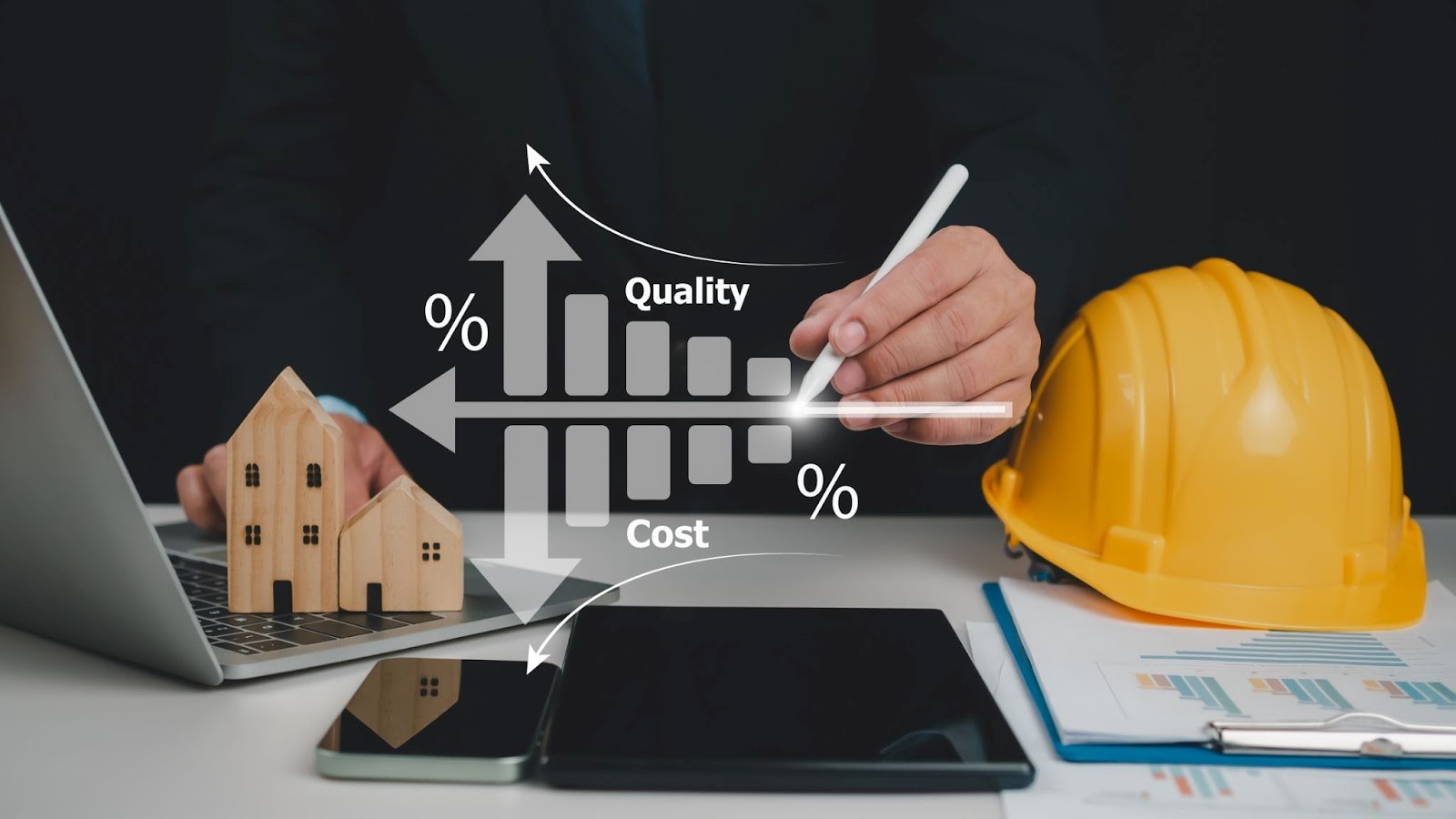Construction Cost Management is important to ensure financial optimization and project success in the construction industry. Traditional approaches face numerous challenges that would negatively affect productivity and accuracy. However, integrating advanced technologies has shifted the conventional practice towards higher effectiveness and precision.
In this blog, we will be discussing what construction cost management means. General assessments of the problems with traditional strategies and the impact of integrating advanced technologies for construction project cost management.
What is Construction Cost Management?
Construction cost management involves identifying and estimating all the project’s costs during its entire life cycle. It also entails setting targets, controlling costs, balancing expenditures, and ensuring that financial resources are used effectively. The aim is to complete a project within the cost constraints while maintaining quality and timeliness.
Cost management is subdivided into cost planning, cost evaluation, cost accumulation, imposing cost control measures, and presenting cost reports. Due to its nature, it resets and depends on collaboration amongst project managers, contractors, financial planners, and stakeholders to ensure transparency and accountability.
Challenges in Traditional Cost Management
- Inaccurate Estimations: Many completed projects develop cost overruns because of incorrect cost estimations resulting from inadequate information or poor coordination between the key stakeholders.
- Unforeseen Variations: Unexpected project scope or design changes are a common cause of additional costs that are not financially manageable.
- Delayed Cost Tracking: In many cases, expenditures are revised only at the end of a week, month, or year, and this kind of planning leads to overrun due to the lack of timely changes.
- Manual Processes: Dependency on manual tracking methods is a common cause of errors and inefficiencies in construction cost management.
- Fragmented Communication: Lack of team collaboration results in slow working progress and misuse of funds.
- Outdated Tools: Traditional methods struggle to adapt to the complexities of modern construction projects, leaving little room for scalability.
Construction Cost Management Process
There are various important steps involved in the CCM process. Have a look at it below:
- Cost Estimation: Precise estimates to be spent on labor, resources, equipment, and other overheads are decided at this point.
- Budgeting: Distributing the costs of these estimates to several project elements
- Cost Control: Comparing the original budgeted costs with the amount incurred in the ongoing capital project constantly helps control costs.
- Reporting and Communication: There should be good communication channels between the concerned stakeholders concerning financial statuses over the project life cycle.
How Technology is Revolutionizing Cost Management

e-Builder an advanced technology tool helps enhance the approach toward construction cost management to overcome inconveniences often linked with manual methods. Using technology and getting data at the construction site or the construction site plan, capital project managers can boost accuracy, efficiency, and decision-making.
Key Benefits of Technology in Cost Management Include:
- Better cooperation and transparency at every phase of the project.
- CCM can be enhanced with the help of e-Builder to track all sorts of resources in real-time.
- Better communication through centralized platforms.
- The advanced activity analysis aids in improved forecasts and risk management.
Key Technologies Transforming Cost Management in Construction
- Advanced Construction Management Software: e-Builder facilitates effective construction cost management processes by giving the project manager to track costs, manage budgets, and ensure compliance with financial goals. This tool offers immediate information and accomplishes activities systematically, so the possibility of manual error is low.
- Data Analytics and Forecasting: It signifies better historical data analysis through data analytics to develop future trends and cost expectations. Advanced forecasting models enable project teams to see potential risk areas and adjust the budget accordingly. This results in greater financial control.
- Integration of Building Information Modeling (BIM): BIM technology can be integrated with the e-Builder, which entails the development of project models. BIM can assess costs associated with material, manpower, and time required by different stakeholders. With the integration of BIM, stakeholders, and project managers can make informed decisions and optimize the resources accordingly.
- AI and Machine Learning: AI-based tools help streamline costs, risk assessment, overall scheduling, and project planning. ML can also help process big data sets and look for patterns, recognize over-budget outbreaks, and describe the best measures to increase productivity.
- Drones and IoT: Drones and IoT devices offer actual-time information from the construction site, helping monitor and track. The effectiveness of this technology aligns resource management and cost agility with project goals.
Benefits of Tech-Driven Cost Management with e-Builder
e-Builder boosts construction cost management by providing real-time insights into finances and resource allocation. This tool ensures that your capital project is managed efficiently and transparently. Here’s how e-Builder’s advanced technology improves a project’s success:
- Accuracy: Software tools help reduce cost estimating and control inefficiencies by providing accurate data.
- Efficiency: e-Builder automates routine tasks, which allows project managers to focus on other important tasks.
- Transparency: Sharing data in real-time enhances the chances of sharing feedback, enabling better decision-making throughout the project lifecycle.
- Scalability: e-Builder can be customized according to the project’s needs. This ensures smooth functionality and easy data analysis.
- Cost Savings: Utilizing e-Builder leads to significant cost savings by enhancing resource allocation and monitoring in real-time. Therefore, this tool is important for modern capital projects.
Steps to Implement Technology in Cost Management
Implementing technology in construction cost management requires a strategic approach. Follow these steps to ensure a smooth transition:
1. Assessment
Examine the current ways to control expenses and identify where changes are needed. Understand your team’s particular challenges and determine explicit goals for technology implementation.
2. Tool Selection
Choose the right tools and platforms that align with your project needs. Consider factors such as scalability, ease of use, and compatibility with existing systems. For best outcomes and better efficiencies, one can choose e-Builder.
3. Partner with Experts like OnIndus
Get in touch with the best capital project advisor and collaborate with them. OnIndus, an e-builder technology partner, specializes in integrating technology into construction processes. Our expertise can help you navigate challenges and achieve goals.
4. Team Training
Ensure everyone on your team is adequately trained to use the advanced features of e-Builder. Conduct timely sessions and training to familiarize them with the updated features of capital project management tools.
5. Monitoring and Optimization
Constantly monitor the construction cost management system and make changes if necessary. For any capital project to grow, one should critically analyze its strengths, weaknesses, opportunities, and threats (SWOT analysis).
Conclusion
Every dollar counts in a capital project, and effective cost management is highly appreciated for the project’s success. However, managing costs is not just about staying within budget. It’s about allocating, tracking, optimizing, and delivering resources. With the Integration of e-builder for construction cost management, capital project managers can leave behind traditional processes and achieve success through enhanced efficiency and accuracy.
OnIndus specializes in seamlessly integrating e-Builder into your capital project processes, customized solutions to meet your specific needs. By leveraging our deep knowledge of capital project management and e-Builder integration, we help eliminate inefficiencies caused by outdated practices, such as manual processes and fragmented communication.
The question is not whether you should adopt technology—it’s whether you are ready to lead the charge toward a more profitable future.
Step into the future of construction. Contact OnIndus for a consultation on integrating e-Builder and revolutionizing your cost management strategy.

